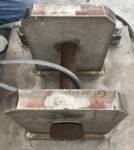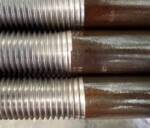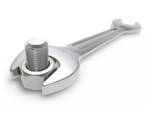Technical FAQs
Hot Rolled Round Bar Tolerances
What are the tolerances for round bar?The bars we use to manufacture your bolts are rolled by the steel mill with standard tolerances for diameter, out of roundness, and straightness. ASTM A6 covers many of these tolerances, as well as the chemical and dimensional tolerances for other shapes and plates. Because round bar is what we primarily use, we will stick... Read more

Stainless Rust
Why are the hex heads of my stainless steel bolts developing rust?There are two possible causes for this. First is that oxidation can occur due to contamination from equipment that is used to make other carbon steel products. This can leave some iron deposits that will rust over time. This is only aesthetic, but can be unsightly. The second possibility is that the bolts were not... Read more
Wrapped Anchor Bolts
My plans call for a section of the anchor bolts on the project to be wrapped with tape. Can Portland Bolt quote this?Although uncommon, there are times when a project’s specifications or plans call for the unthreaded portion of an anchor bolt to be wrapped with various kinds of tape. This tape typically starts at the bottom of the threads projecting from the concrete and will either travel the entire length of the anchor bolt or stop at... Read more

Locking Tie Rod Assemblies
How do you lock a tie rod assembly in place?The easiest way to lock a tie rod assembly in place is by including an extra nut that can be run up against either the clevis or the turnbuckle. Once the nut has been jammed in place the assembly will be unable to move. These pictures show that the nut has to be placed on... Read more

Turnbuckle Dimensions
How are turnbuckles measured?A turnbuckle body is designated by the diameter of the rod threading into it and the length of the take-up inside the turnbuckle rather than the overall length. For example, a 1” x 6” turnbuckle body has an overall length of 8⅞”, but has an opening or “window” measuring 6”. Common sizes available are 6”,... Read more

Thread Runout
What is “thread runout” and what specifications cover it?The thread runout portion of a bolt is where the threaded section transitions into the bolt shank. This area exists beyond where the usable thread stops. In other words, if you were to assemble a nut all the way onto a bolt, the nut will stop, but there will still be a small portion of... Read more
Tightening Bolts by the Head
Can I tighten A325 and A490 structural bolts by turning the head of the bolt?Yes. Per the RCSC Specification for Structural Joints Using High-Strength Bolts (2014), section 8.2, it says: “When it is impractical to turn the nut, pretensioning by turning the bolt head is permitted while the rotation of the nut is prevented, provided that the washer requirements in Section 6.2 are met”
Pitch Diameter Bolts with Timber Connectors
Can I use reduced body bolts with shear plates and split rings?Although ASME B18.2.1 allows for reduced body diameter bolts (where the unthreaded shank is equal to the pitch diameter of the threads), the American Wood Council does not. In Section 13.1.3.3 of the 2015 National Design Specification for Wood Construction, it says: “Bolts used with split ring and shear plate connectors… shall have an unreduced... Read more

Turn of Nut Method
What is the turn of the nut method, and does it apply to anchor bolts?The turn of the nut method is a very popular and reasonably reliable method for tensioning (F3125) A325 and A490 structural bolts without the need for expensive torque wrenches or tension measuring devices. It is a simple guide that tells the user to rotate the nut a specified amount depending on the bolt length and... Read more
Leveling Nuts
Can I use a full size nut as a leveling nut?In most situations you can. A leveling nut is a term that refers to the application of the nut rather than the physical dimensions of the nut. Many times they are called out as “jam” or “half” nuts because they can be cheaper, do not need to provide structural value, and are just used for leveling purposes. ... Read more
